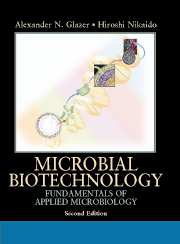Book contents
- Frontmatter
- Contents
- Preamble
- Acknowledgments
- 1 Microbial Diversity
- 2 Microbial Biotechnology: Scope, Techniques, Examples
- 3 Production of Proteins in Bacteria and Yeast
- 4 The World of “Omics”: Genomics, Transcriptomics, Proteomics, and Metabolomics
- 5 Recombinant and Synthetic Vaccines
- 6 Plant–Microbe Interactions
- 7 Bacillus thuringiensis (Bt) Toxins: Microbial Insecticides
- 8 Microbial Polysaccharides and Polyesters
- 9 Primary Metabolites: Organic Acids and Amino Acids
- 10 Secondary Metabolites: Antibiotics and More
- 11 Biocatalysis in Organic Chemistry
- 12 Biomass
- 13 Ethanol
- 14 Environmental Applications
- Index
- Plate section
10 - Secondary Metabolites: Antibiotics and More
Published online by Cambridge University Press: 05 June 2012
- Frontmatter
- Contents
- Preamble
- Acknowledgments
- 1 Microbial Diversity
- 2 Microbial Biotechnology: Scope, Techniques, Examples
- 3 Production of Proteins in Bacteria and Yeast
- 4 The World of “Omics”: Genomics, Transcriptomics, Proteomics, and Metabolomics
- 5 Recombinant and Synthetic Vaccines
- 6 Plant–Microbe Interactions
- 7 Bacillus thuringiensis (Bt) Toxins: Microbial Insecticides
- 8 Microbial Polysaccharides and Polyesters
- 9 Primary Metabolites: Organic Acids and Amino Acids
- 10 Secondary Metabolites: Antibiotics and More
- 11 Biocatalysis in Organic Chemistry
- 12 Biomass
- 13 Ethanol
- 14 Environmental Applications
- Index
- Plate section
Summary
The preceding chapter described the industrial production of some primary metabolites, including citric acid and amino acids. In contrast to these compounds, which are present in most living organisms and are produced by the ubiquitous major metabolic pathways, secondary metabolites are produced only by special groups of organisms through specialized pathways. Their chemical structure tends to be complex, and they are often produced only during the special growth phase, most often during the stationary phase. The most important of these secondary metabolites are the antibiotics.
Many science historians argue that among the many scientific discoveries of the twentieth century, that of the first antibiotic, penicillin (Figure 10.1), by Alexander Fleming (reported in 1928) is the discovery that had the largest impact on human life. The story is well known. Fleming is supposed to have kept a rather untidy laboratory and to have discovered, after returning from his vacation, that the bacterial colonies neighboring a contaminating mold colony were lysed on one of the Petri plates left on his bench. This story is often cited as an example of the importance of serendipity in science. This view, however, totally disregards the fact that Fleming dedicated his entire career to the search for natural products that lyse bacterial cells, in an effort to find agents that could be used in the treatment of bacterial infections. He had, in fact, discovered the enzyme lysozyme several years earlier but was disappointed that most human pathogens were intrinsically resistant to its lytic action.
- Type
- Chapter
- Information
- Microbial BiotechnologyFundamentals of Applied Microbiology, pp. 324 - 397Publisher: Cambridge University PressPrint publication year: 2007

